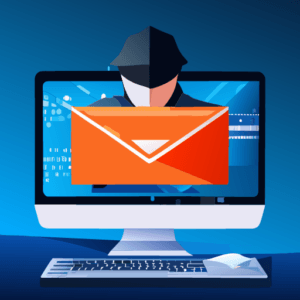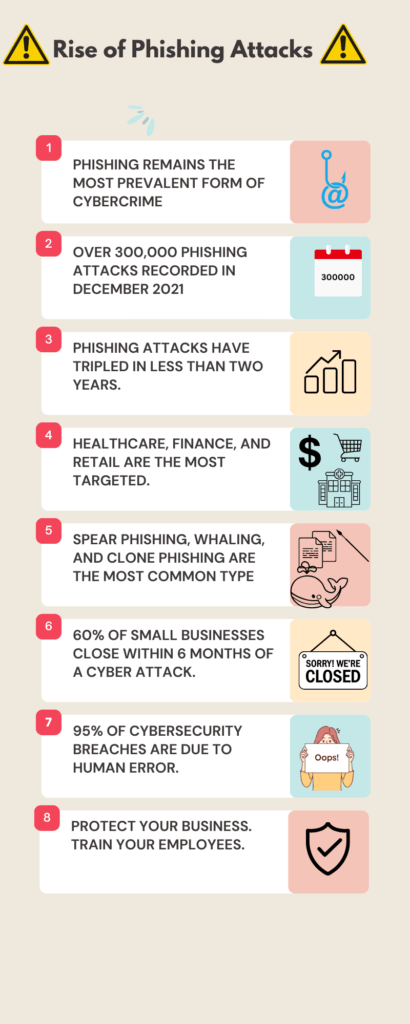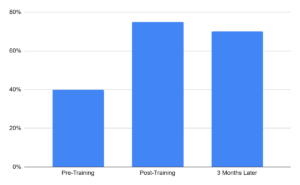
2023-10-7 01:21:12 Author: securityboulevard.com(查看原文) 阅读量:8 收藏

Introduction
In today’s digital landscape, the significance of employee training for phishing emails cannot be overstated. Phishing attacks are on the rise, targeting businesses large and small. Employees often serve as the first line of defense against these cyber threats. Yet, without proper training, they can also become the weakest link, inadvertently granting hackers access to sensitive company data. This article aims to unlock the secrets of effective phishing awareness training, equipping your team with the skills and knowledge needed to thwart these increasingly sophisticated attacks.
Types of Phishing Attacks
Phishing is a cybercrime where attackers impersonate legitimate entities to deceive individuals into revealing sensitive information, such as login credentials or financial details. Now that we’ve defined phishing, let’s delve into its various types to better understand the landscape of these cyber threats.
Spear Phishing
This targeted form of phishing aims at specific individuals or organizations. Attackers often gather detailed information to make the attack more convincing.
Whaling
Whaling attacks focus on high-profile targets like CEOs or CFOs, attempting to manipulate them into transferring funds or revealing sensitive company data.
Vishing
Short for “voice phishing,” vishing involves attackers using phone calls to trick individuals into giving away personal information.
Understanding these types of phishing attacks is crucial for effective employee training, as it allows for more tailored and relevant training modules.
The Rising Threat of Phishing Attacks in 2023

In 2023, the threat of phishing attacks is more severe than ever. According to recent statistics, phishing remains the most prevalent form of cybercrime, affecting both individuals and businesses. The number of phishing attacks has skyrocketed, hitting an all-time high in 2021 with over 300,000 recorded incidents in December alone. This alarming trend shows no signs of slowing down, making it crucial for businesses to take proactive measures.
Why Employee Training is Crucial in Combating Phishing
In the battle against phishing, employees often emerge as the weakest link. Lack of awareness and training makes them susceptible to deceptive emails, inadvertently becoming entry points for cybercriminals. However, this vulnerability can be flipped into an asset. Through comprehensive training, employees can learn to identify phishing attempts, thereby becoming a robust first line of defense. By investing in employee training for phishing emails, you’re not just patching a security hole; you’re transforming your workforce into vigilant guardians of your digital realm.
What Constitutes Effective Phishing Training?
An effective phishing training program goes beyond mere awareness; it equips employees with the skills to identify and respond to various types of phishing attacks. The program should be interactive, incorporating real-world simulations and hands-on exercises. It must also be ongoing, with regular updates to address evolving threats. Metrics should be in place to gauge the program’s effectiveness, allowing for timely adjustments. Ultimately, an effective training program turns theoretical knowledge into practical skills, making employees not just aware but also proactive in combating phishing.
Key Components of a Robust Training Program
To build a robust training program for phishing emails, several key components must be in place:
- Needs Assessment: Evaluate the current level of awareness and the specific needs of your employees.
- Curriculum Design: Develop a structured curriculum that covers various types of phishing attacks and prevention methods.
- Content Creation: Generate informative and engaging content that resonates with the target audience.
- Interactive Exercises: Incorporate quizzes, games, and other interactive elements to reinforce learning.
- Real-world Simulations: Use simulated phishing campaigns to test employees’ ability to identify and respond to attacks.
- Ongoing Training: Keep the training updated with the latest threats and prevention techniques.
- Metrics & Feedback: Implement metrics to gauge the effectiveness of the training and gather employee feedback for improvements.
- Adjustments & Updates: Make timely adjustments based on metrics and feedback.
- Continuous Monitoring: Regularly monitor the program’s effectiveness and make necessary updates.
By incorporating these components, you’ll create a comprehensive and effective training program that not only educates but also empowers your employees.

Real-world Examples of Unsuccessful Phishing Training
Understanding the real-world impact of phishing attacks can offer invaluable insights into the importance of employee training. Below are case studies that highlight both successful and unsuccessful outcomes:
Upsher-Smith Laboratories
In this unfortunate case, employees were deceived into making wire transfers totaling nearly $39 million. The employees took the phishing emails at face value without confirming their legitimacy. The lesson here is to always confirm unusual financial requests and be wary of emails that demand urgency and confidentiality.
Twitter Phishing Case (2020)
Twitter faced a significant breach when employees shared their credentials, leading to high-profile account takeovers. The employees lacked proper phishing protection and awareness, making them easy targets. The key takeaway is the critical need for proper cybersecurity strategies and comprehensive employee education.
Lessons for Your Business
These case studies underscore the importance of employee training for phishing emails. They show that even large, well-known companies can fall victim to phishing if their employees are not adequately trained. Therefore, investing in a robust training program is not just advisable but essential.
Case Studies Table
| Upsher-Smith Laboratories | Twitter Phishing Case (2020) | |
|---|---|---|
| Situation | Wire transfers of nearly $39 million | High-profile account takeovers |
| Employee Negligence | Took phishing emails at face value | Lack of phishing protection and awareness |
| Lessons Learned | Confirm unusual requests; be cautious of urgent emails | Implement proper cybersecurity strategies and employee education |
| Outcome | Unsuccessful | Unsuccessful |
This layout should make it easier to compare the two case studies side by side. Would you like to proceed with anything else?
By studying these real-world examples, businesses can better understand the risks involved and take proactive measures to educate their employees.
How to Choose the Right Platform for Your Business
Selecting the right training platform is crucial for the success of your employee training program for phishing emails. Here are some tips to ensure that the platform you choose aligns with your business needs and goals:
- Understand Your Needs: Assess the specific requirements of your business. Do you need a platform that offers real-world simulations, or are interactive exercises sufficient?
- Budget Constraints: Determine your budget for the training program. Some platforms offer tiered pricing, allowing you to scale as your needs grow.
- Customization: Look for platforms that allow customization. Tailoring the training material to your business can make the program more effective.
- User Experience: A platform with an intuitive user interface will encourage employee engagement. Test the platform’s usability before committing.
- Scalability: As your business grows, your training needs will too. Choose a platform that can scale with your business.
- Reporting and Analytics: Metrics are crucial for assessing the effectiveness of the training. Ensure the platform offers detailed reporting and analytics.
- Compliance: Make sure the platform complies with industry regulations and standards, especially if you’re in a regulated sector like healthcare or finance.
- Customer Support: Reliable customer support can be a lifesaver. Check reviews or get references to assess the quality of support.
- Free Trials: Many platforms offer free trials. Take advantage of this to assess whether the platform meets your needs.
- Peer Reviews: Lastly, consult reviews and get recommendations from peers in your industry. Their insights can be invaluable.
By carefully considering these factors, you can choose a training platform that not only meets your current needs but also scales with your future growth.
Implementing Your Employee Training for Phishing Emails

Implementing a successful employee training program for phishing emails involves several key steps. Here’s a step-by-step guide to help you navigate this process:
- Identify Needs: The first step is to identify the specific training needs of your employees. This will help you tailor the program effectively.
- Select Platform: Based on your needs and budget, select a training platform that aligns with your business goals.
- Customize Curriculum: Customize the training material to make it relevant to your business and industry.
- Train the Trainers: Before rolling out the program, ensure that the trainers are well-versed with the material and the platform.
- Launch Pilot Program: Start with a small group of employees to test the effectiveness of the training program.
- Gather Feedback: After the pilot, gather feedback from participants to identify areas for improvement.
- Make Adjustments: Use the feedback to make necessary adjustments to the curriculum or the training methods.
- Roll Out Program: Once you’re satisfied with the pilot, roll out the program to all employees.
- Monitor & Update: Continuously monitor the program’s effectiveness and make updates as needed.
By following these steps, you’ll be well on your way to implementing a successful employee training program for phishing emails.
Monitoring and Feedback
To ensure the long-term success of your employee training for phishing emails, continuous monitoring and feedback are essential. Here’s how you can keep track of key performance indicators (KPIs):
Key Metrics to Monitor
- Engagement Rate: This measures the level of active participation in the training program.
- Completion Rate: Keep track of the percentage of employees who complete the training.
- Knowledge Retention: Use quizzes or tests to gauge how well employees retain the information.
- Incident Reduction: Monitor the decrease in actual phishing incidents after the training.
- Employee Feedback: Collect qualitative data from employees to assess their training experience.
For Example: Employee Training Completion Rates

- Completed: 80%
- Partially Completed: 15%
- Not Started: 5%
Another Example: Knowledge Retention Over Time

- Pre-training: 40%
- Post-training: 75%
- 3 Months Later: 70%
Importance of Feedback
Feedback from employees can offer valuable insights into the effectiveness of the training program. Use surveys or one-on-one interviews to gather this information.
Making Adjustments
Based on the metrics and feedback, make necessary adjustments to the training program. This could mean updating the curriculum, changing the training methods, or even switching to a different platform.
By diligently monitoring these metrics and listening to employee feedback, you can continually refine your training program, making it more effective over time.
FAQs
What is Phishing Awareness Training for Employees?
Phishing awareness training educates employees on how to identify and respond to phishing attempts. The training often includes simulated phishing campaigns to test employees’ awareness and provide real-time feedback.
How Often Should Phishing Training be Conducted?
The frequency of phishing training can vary, but it’s generally recommended to conduct training sessions at least quarterly. Ongoing training is crucial as phishing techniques evolve rapidly.
What Metrics Should Be Tracked to Measure the Effectiveness of Phishing Training?
Key metrics include the click-through rate on simulated phishing emails, the number of employees who report phishing attempts, and changes in behavior over time. Monitoring these metrics helps in refining the training program.
Conclusion and Next Steps
In conclusion, employee training for phishing emails is not just an option but a necessity in 2023. With the rising threat of sophisticated phishing attacks, businesses can’t afford to overlook this crucial aspect of cybersecurity. Effective training programs, coupled with ongoing monitoring and feedback, can turn your employees from potential vulnerabilities into first-line defenders against cyber threats.
Next Steps: Don’t wait for a cyber incident to take action. Start evaluating your current security posture and invest in a comprehensive phishing awareness training program today. Your business’s security is only as strong as its weakest link—make sure that’s not your employees.
Ready to take the next step in securing your business? Contact us now to get started on implementing a robust employee training program for phishing emails.
The post Unlock the Secrets of Employee Training for Phishing Emails: 2023 Guide appeared first on Endpoint Security.
*** This is a Security Bloggers Network syndicated blog from Endpoint Security authored by Michael Toback. Read the original post at: https://smallbizepp.com/phishing-training/?utm_source=rss&utm_medium=rss&utm_campaign=phishing-training
如有侵权请联系:admin#unsafe.sh
